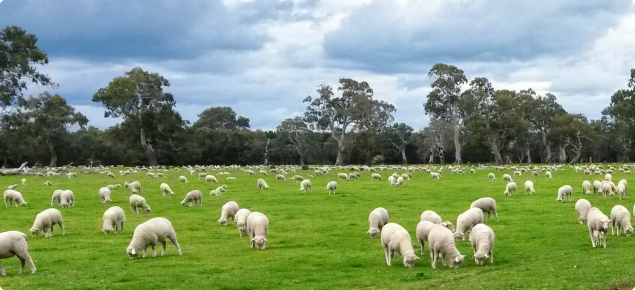Existing data shows WA’s south west is becoming drier and hotter, while future climate projections based on greenhouse gas emissions indicate the trend will continue – presenting challenges for pasture and animal production.
The FutureSheep project is laying the groundwork to capture data from which to model projected climates from several of the key sheep producing regions, including Bruce Rock, Kojonup and Wagin. The project will look at adaptation options, spanning feedbase alternatives, animal management and genetics, as well as business models.
This project complements the existing NEXUS Program, based in the east, by adding WA Mediterranean farming systems to their farm case studies ranging from the north of Queensland to the Midlands of Tasmania. The project will also use information from the FEED365 project, which is conducting a large grazing trial at DPIRD’s Katanning Research Station, to identify pasture systems that can supply feed year-round. The trial data will help inform the forage adaptation choices and NEXUS will assist the project in the business and sheep management. This will be integrated in the modelling and the findings will provide MLA and DPIRD with guidance for new research, development and extension activities.
Objectives
The objectives of the FutureSheep project are:
- to work with sheep producers to identify adaptations to climate change that are profitable, environmentally sustainable and targeted towards future market opportunities.
- to explore the nexus between profitability, productivity, greenhouse gas mitigation, carbon sequestration and consumer perception of livestock businesses in an increasingly variable climate.
Key activities
The FutureSheep project will assess the impact of projected climates in 2030 and 2050 on the economic performance of modelled farms in key sheep producing regions. It will also evaluate how farm turn-off could change in response to future climate and affect supply to feed-lotters and processors.
The FutureSheep project will:
- rely on an independent reference group of producers, consultants and researchers to provide input and ensure that the work is regionally relevant by:
- informing the construction of representative model farms
- defining the adaptation options to be examined
- testing model assumptions
- providing critical feedback on the project findings.
- link to the FEED365 project that is field testing a large array of feedbase options to fill feed gaps and meet specific sheep production objectives in the context of a drying climate.
- conduct a suite of adoption program activities involving workshops, partner farm activities, on-farm walks and case studies.
- undertake economic analysis of future profitability under modelled climate projections and compare current practices and possible adaptation strategies.
- calculate greenhouse gas emissions on each simulated case study farm for a range of sheep production systems now and in the future, based on latest climate projections.
- evaluate how sheep meat supply chains may be impacted by future climate (numbers, location, age and weights).
- investigate adaption strategies to animal management and genetics - e.g. altered management calendars such as changed joining date, improved reproduction or feed conversion efficiency and heat tolerance.
- analyse future business models - enterprise balance (livestock: crops alternatives e.g. conservation grazing models), species mix, alternative markets (e.g. carbon and sustainable farming markets).
Specific technologies and practices to be modelled include:
- altered pasture growth profiles across the growing season and their impact on flock structure and enterprise mix (wool vs meat).
- new feed options to respond to out of season rainfall.
- risk management through business diversification across regions.
Modelled technologies will also provide further information supporting the Meat & Livestock Australia Carbon Neutral by 2030 (CN30) roadmap:
- Animal genetics and husbandry practices to increase production efficiency and reduce methane emissions intensity (per kg of production).
- Pastures, shrubs and legumes that improve livestock productivity and lower emission intensity (per kg of lamb and wool).
- Legumes, pastures and shrubs that build feedbase and carbon stocks above and within soils.
- Trees and shrubs that improve carbon storage, animal health and biodiversity.
- Dung beetles to improve feedbase production, livestock productivity and carbon storage.
Contact information
For more information about the FutureSheep project, please contact DPIRD Development Officer Janet Conte at Janet.Conte@dpird.wa.gov.au or +61(0)8 9368 3206.

